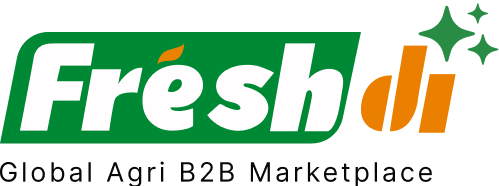Introduction – Germany’s Fruits Market in Statistical Focus
Germany has long held a pivotal role in the European fruit trade, not only as a major importer but also as a consistent exporter of select fruit varieties. Despite a gradual decline in domestic fruit production, Germany remains strategically significant in the global fruit supply chain. In 2023, the country produced approximately 2.45 million metric tons of fruit, a number projected to dip to 2.36 million metric tons by 2028. With such fluctuations in domestic output, the fruits market here is heavily dependent on imports and robust B2B distribution networks.
For businesses looking to source or export fruits to or from Germany, selecting the right supplier is no longer just about price or product availability. A data-driven approach—examining export volumes, market demand, and supplier performance—is essential. That’s where platforms like Freshdi come into play, offering powerful tools for supplier verification, RFQ trend tracking, and real-time market insights.
Deep Dive – Key Production, Export Statistics & Demand Insights
Domestic Production Trends
Germany’s fruit production has been steadily declining for decades. From 1966 onwards, there has been an average annual decrease of 3.7%. By 2028, it’s expected that national fruit output will fall to 2.36 million metric tons, highlighting the need for increased imports and stronger supplier partnerships.
Export Dynamics
In 2024, Germany exported fresh strawberries worth $29.07 million, with Austria being the top destination, importing over $12 million in strawberries. Other significant buyers included the Czech Republic and the Netherlands. However, overall export volumes took a hit due to growing competition and logistical challenges.
Import Trends and Growing Demand
Germany’s internal fruit consumption is forecasted to reach 9.8 million metric tons by 2028, slightly down from 9.9 million in 2023. While that might seem modest, the drop is part of a longer-term trend of decreasing per capita consumption. To bridge the domestic production gap, Germany relies heavily on fruit imports from countries such as the Netherlands, Spain, Italy, Morocco, and Egypt.
Emerging Players in the Market
Morocco and Egypt have rapidly grown their footprints in the German market. From January to March 2024 alone, Morocco exported nearly 35,000 tons of fruit and vegetables to Germany—a 40% increase compared to the prior year. Similarly, Egypt’s strawberry exports to Germany reached 3.69 thousand metric tons between July 2024 and April 2025, up 87% over previous years.
Market demand data from platforms like Freshdi shows a corresponding increase in RFQs related to strawberries, raspberries, and greenhouse-grown produce—perfectly aligning with these export trends.
Top 7 Verified Fruits Suppliers in Germany – Top Tier Based on Export Data
Choosing the right supplier means looking at more than just product catalogs. On Freshdi, suppliers are vetted based on actual trade data, certifications, customer feedback, and RFQ responsiveness. Here are the top 7 fruits suppliers in Germany for July 2025:
-
GE Business Link GmbH
Known for its range of frozen fruits and vegetables, this supplier has built a reputation for reliability, especially in B2B streams. -
INTERFRUITS UG (HAFTUNGSBESCHRÄNKT)
Specializing in both fresh and dried fruits, this company ranks high in export volumes and customer satisfaction. -
Amy-export
A rising star in the German export scene, Amy-export focuses on niche fruits and seasonal specialties, earning high marks for responsiveness. -
IMPORT & EXPORT SOLEIL / SOLEILFOOD
Offers a wide assortment of dried fruits and nuts, catering to both retail and wholesale buyers across Europe. -
Shree Ug
A multi-category supplier with a growing portfolio of organic fruits, Shree Ug is known for its transparent sourcing and certifications. -
Hossein Shafaie
Specializes in bulk exports of exotic fruits and has recently expanded into soft-dried fruit snacks for the European market. -
Baraoc Edibles & Herbs E.K.
A go-to supplier for herbs and fruit derivatives, this company is well-regarded for quality control and on-time delivery.
Dynamic Ranking Note
Keep in mind that supplier rankings can shift monthly. Platforms like Freshdi offer dynamic updates through features like “Suppliers of the Month” or “Quarterly Export Champions,” reflecting real-time performance and market activity.
Market Navigation – Statistical Trends, Pricing Analysis & Export Dynamics
Changing Import Patterns
Germany’s fruit imports have dropped from 9.2 million tons in 2021 to 8.3 million tons in 2023. But here’s the twist—the import value actually increased to €13.5 billion in 2023, pointing to a sharp rise in fruit prices. This is a classic supply-demand mismatch, where reduced volumes are being traded at higher prices.
Seasonal Demand and Price Fluctuations
Seasonality plays a huge role in fruit pricing. For example, in Q1 2024, Germany saw a spike in frozen raspberry prices due to a global supply shortage. Morocco stepped in, quadrupling their exports to help stabilize the market. If you’re a buyer, knowing when to make your move can save you big bucks.
Product Category Insights
- Strawberries: High-volume exports from Egypt and local production in decline make this a high-demand import category.
- Raspberries and Blueberries: Seasonal shortages often lead to price surges—Moroccan and Eastern European suppliers fill the gaps.
- Citrus Fruits: Spain still leads here, but competition is rising from Egypt and Turkey.
- Exotic Fruits: Vietnam is now making inroads with products like dragon fruit and longan, especially after their big showing at Fruit Logistica 2025.
New Entrants and Trends
- Vietnam’s Expansion: At Fruit Logistica 2025 in Berlin, Vietnam made its largest-ever market push, showcasing products like mango, durian, and soft-dried fruit snacks.
- Fosacha’s Debut: This Vietnamese brand entered the German market in January 2025 with high-end dried fruit products, signaling a growing appetite for premium snacking options.
Conclusion – Leveraging Data for Informed Procurement
Germany’s fruit market is in flux, shaped by declining local production, dynamic global sourcing, and shifting buyer preferences. For exporters and importers alike, the key lies in leveraging real-time data and market intelligence to navigate these changes.
By using platforms like Freshdi, businesses can:
- Access verified supplier profiles with export performance metrics
- Monitor RFQ trends and seasonal demand shifts
- Stay updated with market rankings and supplier certifications
- Make procurement decisions backed by stats, not guesswork
In a competitive B2B landscape, the edge goes to those who stay informed and act fast. Whether you’re sourcing strawberries from Egypt or exploring new dried fruit categories from Vietnam, let data guide your decisions.
Key Takeaways
- Germany’s fruit production is declining, increasing its dependency on imports.
- Morocco and Egypt are emerging as key fruit exporters to Germany.
- Seasonal shifts and global demand affect pricing significantly.
- Verified suppliers on Freshdi offer transparency and reliability.
- Real-time trade data is critical for smart procurement.
Buyer’s Checklist: Sourcing Fruits in Germany
✅ Check supplier export history and certifications
✅ Compare seasonal pricing data before placing large orders
✅ Use platforms like Freshdi for RFQ tracking
✅ Explore alternative suppliers from emerging markets like Vietnam and Morocco
✅ Prioritize suppliers with high customer ratings and response times
Future Outlook – What’s Next for Germany’s Fruit Market?
- Increased Organic Demand: With inflation dropping, organic fruit sales are picking up.
- Diversification of Import Sources: Beyond EU, expect more from Africa and Southeast Asia.
- Premium Products Rising: More demand for high-quality dried and exotic fruits.
- Smart Procurement Tools: AI-driven platforms like Freshdi will become essential for B2B buyers.
FAQs
1. Why is Germany importing more fruits despite being a producer?
Germany’s own fruit production is declining due to climate, labor, and cost factors. Imports fill the gap.
2. What fruits does Germany import the most?
Strawberries, citrus fruits, berries (especially raspberries and blueberries), and exotic fruits like mangoes and dragon fruits.
3. How can I verify a fruit supplier in Germany?
Use platforms like Freshdi to access verified profiles, export data, and customer reviews.
4. What’s the best time to buy fruits at lower prices in Germany?
Off-season months often see lower prices, but it varies by fruit. Use historical pricing data for planning.
5. Are there organic fruit suppliers in Germany?
Yes, and their numbers are growing. Many Freshdi suppliers offer certified organic options.
References
- reportlinker.com
- wits.worldbank.org
- indexbox.io
- east-fruit.com
- freshplaza.com
- hortidaily.com
- tridge.com
- fruitnet.com
- vietnam.vnanet.vn
- fosacha.com
- Freshdi


